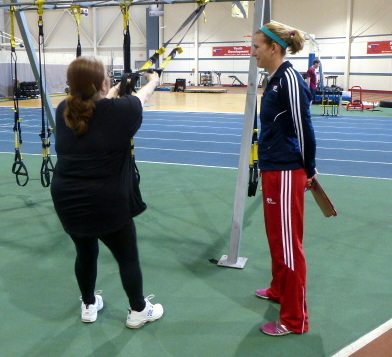
Charter member Rick Hurst talks about his favorite activities at NIFS and what has kept him coming back for 25 years. Click here to watch his video.
by Trudy Coler, on Nov 19, 2013 12:59:00 PM

Charter member Rick Hurst talks about his favorite activities at NIFS and what has kept him coming back for 25 years. Click here to watch his video.
by Tara Rochford, on Oct 22, 2013 1:39:00 PM
With NIFS being located on the campus of IUPUI, it is hard not to notice the campus’s schedule and all of the students bustling between classes. Several students stop into our fitness center for advice so they can avoid the “freshman 15” or get their healthy habits back on track.
Now that school is in full swing and you have your classes and routine figured out, it is a good time to take a look at your healthy habits or areas that could use a little tweaking in the health department. I know how tough being in college can be, but it doesn’t mean that all healthy decisions have to fall to the wayside. This is a crucial time in your life when new routines are developed, so why not develop healthy habits that you will have for life?
College is a time when you go through many changes all at once, so it’s important to not only focus on putting healthy foods in your body, but also to be healthy physically, mentally, and socially, too! Not to worry; it may be challenging at times dealing with so many new things all at once, but I promise you will make it through.
You may be a new college student, in your third or fourth year of college, preparing to go to college, or helping a loved one get ready for his or her college experience. Whatever the case, these tips will help keep anyone college-bound healthy, balanced, and happy!
1. Create a Routine
Every person functions differently. Some people are planners and some people thrive on spontaneity. Whatever the case, your body needs a little bit of routine. Make sure that you are orderly with things you do each day. For example, keeping your keys, ID cards, and notebooks in the same place each day will save you the stress of searching and scrambling last minute to find these items before each class. This extra time will also allow for more “free time” when you can do spontaneous and fun things to keep your mental and social health balanced.
2. Begin with Breakfast
Breakfast is the meal that boosts your blood sugar and metabolism, and can set the tone for the entire day. Skipping breakfast can lead to moodiness, low blood sugar, and overeating later in the day. Remember that you don't have to eat "breakfast" for breakfast. If you want leftovers from the night before, go for it! The important thing is to include complex carbohydrates, lean protein, and healthy fat to increase your focus, metabolism, and energy. If you don’t want to eat in the dining hall, an easy dorm room breakfast is hot oats cooked in the community microwave topped with a dollop of nut butter and a side of fruit that you grabbed from the dining hall the night before.
3. Hydrate
Keep in mind that the calories in your drinks count toward your daily calories, too. If you are feeling thirsty, you are already dehydrated, and often thirst can be mistaken for hunger. Choose water when you can, and keep a fun water bottle or cup with you at all times to encourage drinking throughout the entire day.
4. Schedule Physical Activity and Make it FUN!
Don’t like going to the gym? You don’t have to! Since I work at NIFS you probably think I am crazy for saying that! The thing is, your body doesn’t know whether you are running inside on a treadmill or playing a game of soccer. What your body does know is it was meant to move, so schedule some fun active time in your day just like a class or appointment. Sign up for an intramural sport, try a group fitness class, join a running group, volunteer at the animal shelter to walk dogs, sign up for a dance class, and get creative! Find something you love and do it.
5. Be Prepared
Although it may be hard to pack an entire healthy meal when living in a dorm, packing a snack can be easy! Some fruits and vegetables require little to no preparation (such as apples, oranges, peaches, cherry tomatoes, and snap peas) and can be thrown into your school bag for an easy energy booster. This can lift your mood and sharpen your focus to help prevent the afternoon blues and help increase your productivity while studying. Having water and emergency snacks on hand will also make it less likely for you to reach for fast food as a regular option.
6. Indulge!
In moderation, it's okay to eat your favorite treat every once in a while. Things like ice cream, fast food, chocolate, or a special coffee drink are perfectly fine to enjoy...sometimes. It's not what you do every once in a while, it's what you do every day that makes a difference.
At NIFS we are here to help, and we couldn’t be more conveniently located for students in central Indianapolis.
We offer fun group fitness classes that are included in your membership. We have a Registered Dietitian on staff who can help you create a meal plan that will work with your campus lifestyle. And our Health and Fitness Specialists will create a workout plan for you for free.
If you have questions about student membership or any of the programs that we have available to help you live a healthy campus lifestyle please e-mail membership at membership@nifs.org.
This blog was written by Tara Deal Rochford, NIFS Membership Manager and a group fitness instructor. Author of Treble in the Kitchen.Meet our other NIFS bloggers.
by Stephanie Kaiser, on Oct 15, 2013 12:00:00 PM
Are you one of the many Americans who are glued to a desk throughout the day? On top of that, do you have other responsibilities outside of your work hours that limit the amount of time that you can spend exercising throughout the week? Here are some ways that you can become more active at work. Remember, 30 minutes of physical activity five days a week can make a huge difference in your long-term health!
1. Bike or Walk to Work
If you can ride a bike or walk to work each day, you can add a significant amount of physical activity minutes to your week. If you have a bike path or walking trail near your home that leads to your work, this is an excellent option. Many do not have this luxury or live too far away, but that doesn’t mean it is completely out of the question. If you have a longer commute, you can drive to a path and park nearby and bike or walk the remainder of the trip. This is a great solution for those who work in busy cities.
2. Take the Stairs
Even if you are stuck at a desk the majority of the day, you can get in some quick cardio bursts if you have a set of stairs in your building. Anytime you have the opportunity to switch to a different floor, utilize the stairs instead of the elevators. For example, instead of using the restroom that is a few steps from your office, take the stairs to a restroom on a different level to sneak in some extra steps. (You can even go up and down a few extra times while you are up!)
3. Walk on Your Lunch Break
Squeeze in a few extra minutes on your lunch break by taking a stroll around the block or through the hallways. If your time is limited, do not underestimate the value of a short 10-minute walk. The small additions of physical activity throughout your day add up fast! Some companies even offer incentive programs at work for walking so be sure to join in!
4. Walk During Meetings and Brainstorms
When possible, have meetings while walking. This can be especially beneficial during brainstorms. Instead of sitting for 20 minutes with a colleague discussing the next task, walk!
5. Desk Exercises
When you feel like you have brain block or just need to pause for a few minutes from what you are doing, complete a few exercises right at your desk! Try alternating between incline push-ups on your desk and body-weight squats for 3 sets, 10 to 15 reps for each exercise, for a quick burst of energy. All you need is your own body weight and your desk!
6. Sit on a Stability Ball
Not all companies will allow this, but if yours does you should definitely take advantage of it! Sitting on a stability ball throughout the day improves posture, strengthens the core, and is an excellent piece of equipment for a few quick desk exercises throughout the day. A regular stability ball will work, but balance ball chairs are excellent and provide additional ergonomic benefits.
7. Stand Up
Simply stand up at your desk when possible! Standing burns more calories than sitting and allows for your body to stretch from the seated position. Oftentimes we need to be seated to complete a job task, but you can easily stand during a phone call or while you are reading a long document. If you want to add an extra burst of cardio along with this, try marching in place to increase your heart rate.
Have specific questions on ways to incorporate more physical activity into your day? Sign up for a free fitness assessment with one of our expert trainers!
This blog was written by Stephanie Kaiser, ACSM certified Health Fitness Specialist. Meet our bloggers.
by Trudy Coler, on Jun 4, 2013 11:58:00 AM
Can you find two and a half hours in your weekly schedule to devote to exercise? Most adults would say NO WAY! Not with my job, running the kids around, taking care of the house, and taking care of my parents. We are all busy, but the truth is, it only takes two-and-a-half hours a week of your time to lower your risk for diseases such as cardiovascular disease, Type-2 Diabetes, and some cancers, according to the Centers for Disease Control and Prevention.

The Health Benefits of Even a Little Activity
Would you be able to complete your list of to-dos if you were dealing with a serious health condition? The same amount of activity will also help you to control your weight, improve your mental health, and increase the strength of your bones and muscles. Wouldn’t it be great to feel stronger physically and emotionally and to have more energy throughout the day? It is possible!
Take one of my clients who has a very hectic schedule himself that changes constantly, making it difficult to make it in to NIFS every day. To combat this, he has purchased a foot peddler that he keeps at his desk to sneak in some extra physical activity when he is working to keep him on track with his fitness goals.
Fitting in Small Bouts of Exercise at Work
Think about what works for your situation and how you can find the time. Another option is to take a few minutes to complete a few exercises at your desk such as an incline push-up or body-weight squat followed by a quick walk around your office space or up and down the stairwell. Other quick-fix options include parking farther away from the front door of the store or at work, or taking the stairs instead of the elevator. You can do similar activities pretty much anywhere when you have a few minutes of downtime!
Finding the time is easier than you think! Even small bouts of exercise of only 10 minutes can contribute to your weekly total. First try to find time twice a day every day to walk for just 10 minutes. You only need to find 15 times a week (twice a day plus one extra) where you have 10 minutes to spare to reach your two-and-a-half hours! You could do this on your lunch break, while you are watching your kids practice, or by waking up 10 minutes earlier. Gradually, start adding more bouts of ten-minute activities into your day where you see fit. Making this positive change will make a huge difference in your health and you will be thanking yourself later in life for your lifestyle changes today!
Take that first step towards a more active lifestyle. Put down that mouse or smart phone right now and go for a 10-minute walk!
This blog was written by Stephanie Greer, NIFS certified Health Fitness Specialist. Meet our blogging fitness specialists at the NIFS website.
by Trudy Coler, on Apr 23, 2013 12:45:00 PM

A Heart Attack Can Begin a Vicious Cycle of Depression and a Sedentary Lifestyle
A heart attack is a life-changing event that oftentimes occurs unexpectedly and can turn someone’s life upside-down. According to the American Heart Association, individuals are three times more likely to develop depression after a heart attack. Depression, being over cautious, or fear of another complication often leads these individuals to become sedentary. A sedentary lifestyle is dangerous because it can contribute to other health conditions such as diabetes, hypertension, high cholesterol, and obesity, to name a few. Have you or someone you know become a victim of this reoccurring trend?
Talk to Your Doctor
Ask your doctor questions about physical activity following a heart attack. Your doctor can tell you how to safely add exercise back into your daily routine. They typically recommend starting slowly with low-impact activities such as swimming, walking, or biking, and exercising for only a few minutes at a time in the beginning before building up to longer durations.
So what are you waiting for? Go talk to your doctor about rebooting your activity level! If you have been cleared to begin an exercise routine check out the NIFS Lifestyle Rx Program, which serves individuals who have been dealing with chronic health conditions. This program provides individuals with monitoring and the appropriate tools needed to be successful with their fitness goals based on their fitness level and medical conditions.
This blog was written by Stephanie Greer, HFS at NIFS and Lifestyle Rx Program Coordinator. Contact Stephanie by email.
NIFS blogs are written by our nationally certified and degreed staff on fitness subjects ranging from workouts to nutrition to how to live a healthy lifestyle. We hope you enjoy our tips and insight!